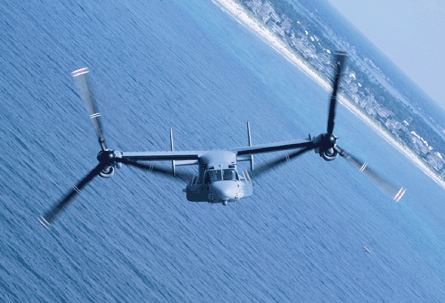The military rotorcraft industry in the USA can expect major change in the next decade. The triumvirate of Bell Helicopter, Boeing and Sikorsky has combined to produce only one all-new aircraft type in the past 30 years - the Bell Boeing V-22 Osprey tiltrotor. No new aircraft model is in the pipeline, so nothing new is likely to enter production within the next decade.
Moreover, new orders for the Boeing CH-47, Boeing AH-64, the V-22 and the Sikorsky UH-60 - the mainstays of the domestic rotorcraft industrial base since the early 1980s - are expected to expire in or shortly after 2017.
This near-absence of airframe innovation over a span of roughly four decades is quickly catching up with the industry. From the corridors of the Department of Defense to investor conferences on Wall Street, decision-makers are beginning to realise that the rotorcraft industry is heading for massive change without a rapid and dramatic intervention.
 |
|---|
© Bell Helicopters |
"There's almost no way that [the market] will be enough to keep three US manufacturers intact, especially with ongoing competitive pressure from foreign producers, assuming a continued open door procurement policy," says Richard Aboulafia, vice-president of the Teal Group. The problem for US manufacturers is most acute in the lucrative medium and heavy military rotorcraft sector. Last month, the Forecast International consulting firm estimated that this sector will produce 3,924 rotorcraft worth $88.1 billion over the next decade.
However, Forecast analyst Raymond Jaworowski says the market will not favour US producers. "The medium/heavy military market has largely become a competition between all-new rotorcraft from non-US manufacturers and improved derivative models, based on older designs, from US firms," Jaworowski says. "This situation came about primarily because of the US military's preference, in years past, to procure improved versions of helicopters already in its fleet rather than pursue the development of new rotorcraft."
DERIVATIVE MODELS
Neither US industry executives nor government planners can claim no-one saw the problem coming. In 2004, Pentagon planners issued a report on the vertical lift industrial base highlighting US industry's reliance on derivative models. The report warned that failure to act soon "could cede the most technologically challenging work in rotorcraft applications to new entrants or to the global industrial base".
A seeming paradox is the robust sales for US military rotorcraft since the global war on terrorism began in 2001. More than seven years later, the US Army, for one, has added hundreds of new helicopters to a depleted inventory. But this initiative was largely financed by the cancellation of the Sikorsky/Boeing RAH-66 Comanche scout helicopter.
Several military derivatives of commercial helicopters have been added to the army inventory since 2004, but they are increasingly coming from offshore. The US Navy has ordered the Lockheed Martin/AgustaWestland VH-71 as a presidential helicopter and the army has deployed the EADS North America UH-72A as a light utility helicopter.
"There's no such thing as a free lunch, and US rotorcraft makers are enjoying a free decade-long rich and filling banquet," Aboulafia says. "Every single major helicopter requirement is now being satisfied. But there's very little in the R&D pipeline."
Industry officials are already preparing for a production crash, followed by inevitable consolidation. "Unless something changes in the acquisition system and we start developing a new product or extend the heck out of what we have, there will be a downturn in terms of helicopters being produced," says Phil Dunford, Boeing vice-president and general manager for rotorcraft systems. "There's going to be a major tendency to consolidate."
And Pentagon officials have begun to react. James "Raleigh" Durham, director of joint advanced concepts, has conducted a rotorcraft industry "wargame". Durham has kicked off a two-year study to define the military's needs for advances in vertical lift technology going forward. The Future Vertical Lift capabilities-based assessment is expected to propose the launch of a Joint Heavy Lift rotorcraft or a successor to the UH-60 and AH-64.
Source: Flight International























